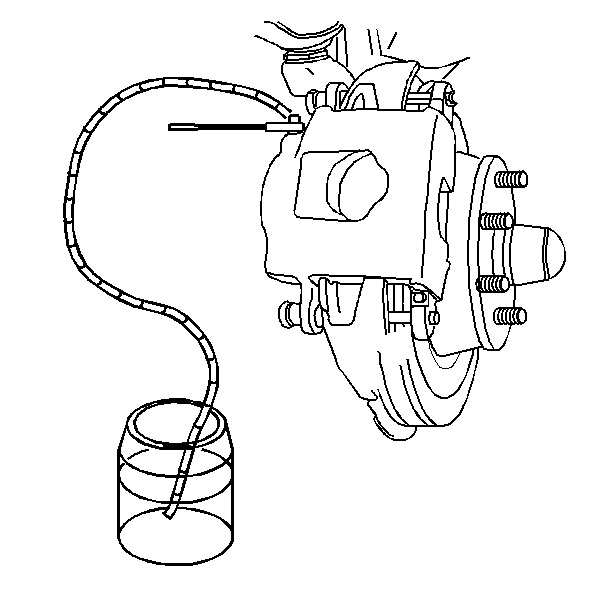Manual Bleeding
Bleeding is necessary if air has entered the hydraulic brake system.
| • | You may need to bleed the system at all four wheels if a low fluid
level has allowed air to enter the system or the brake pipes have been disconnected
at the master cylinder: If a pipe is disconnected at one wheel, then only
bleed that wheel. |
| • | If you removed the master cylinder, you can reduce the time required
to bleed the hydraulic system. Bleed the master cylinder before you reinstall
the master cylinder on the vehicle. |
| • | Use the following procedure if you did not replace the EHCU: |
Notice: Brake fluid will damage electrical connections and painted surfaces.
Use shop cloths, suitable containers, and fender covers to prevent brake fluid
from contacting these areas. Always re-seal and wipe off brake fluid containers
to prevent spills.
- Fill the master cylinder reservoirs with DOT 3 motor vehicle
brake fluid.
Maintain the fluid level during the bleeding procedure.
- Perform the following procedure if the master cylinder is suspected
of having air contamination in the bore.
Bleed the master cylinder before bleeding any brake caliper.
| 2.1. | Disconnect the forward brake pipe connection at the master cylinder. |
| 2.2. | Allow the brake fluid to flow from the connector port. |
| 2.3. | Connect the brake pipe. Do not tighten the brake pipe. |
| 2.4. | Apply the brake pedal slowly. Allow the air to bleed from the
loose fitting. |
| 2.5. | Tighten the fitting before releasing the pedal. |
| 2.6. | Wait for 15 seconds. |
| 2.7. | Repeat this sequence, including the 15-second wait, until all
of the air is plunged from the bore. |
| 2.8. | Repeat the procedure for the rear pipe after all of the air is
removed from the forward connection. |
- Perform the following procedure in order to bleed the brake system:
| 3.1. | Bleed the right rear. Bleed both bleeders one at a time (for Dayton-Walther
only). |
| 3.2. | Bleed the left rear. Bleed both bleeders one at a time (for Dayton-Walther
only). |
| 3.3. | Bleed the right front. |
| 3.4. | Bleed the left front. |

- Attach a hose to the caliper
bleeder valve. Immerse the opposite end of the hose into a container partially
filled with clean brake fluid.
- Slowly apply the brake pedal one time and hold the brake pedal.
- Loosen the bleeder valve in order to purge the air from the caliper.
- Tighten the bleeder valve and slowly release the pedal.
- Wait for 15 seconds.
- Repeat the sequence, including the 15-second wait, until all of
the air is purged from the caliper.
- Continue steps 4-9 at each wheel until the brake system
has been bled.
- Inspect the brake pedal for sponginess.
- Repeat the bleeding procedure if the brake is spongy.
Pressure Bleeding
Bleeding is necessary if air has entered the hydraulic brake system.
| • | It may be necessary to bleed the system at all four wheels if
a low fluid level has allowed air to enter the system or the brake pipes have
been disconnected at the master cylinder: If a pipe is disconnected at one
wheel, then only bleed that wheel. |
| • | If you removed the master cylinder, you can reduce the time required
to bleed the hydraulic system. Bleed the master cylinder before you reinstall
the master cylinder on the vehicle. |
| • | Use the following procedure if you did not replace the EHCU: |
Tools Required
Notice: Brake fluid will damage electrical connections and painted surfaces.
Use shop cloths, suitable containers, and fender covers to prevent brake fluid
from contacting these areas. Always re-seal and wipe off brake fluid containers
to prevent spills.
Use a diaphragm type pressure bleeder. The bleeder must
have a rubber diaphragm between the air supply and the brake fluid in order
to prevent the following from contaminating the hydraulic system:

- Fill the pressure tank at least 2/3 full with brake fluid. Bleed
the bleeder each time the fluid is added.
- Charge the bleeder to 140-170 kPa (20-25 psi).
- Connect the hose from the bleeder to the adapter.
- Open the tank valve.
- Bleed the brake system in the following sequence:

- Attach the hose to the
bleeder valve. Immerse the opposite end of the hose into a container that
is partially filled with clean brake fluid.
- Open the bleeder valve at least 3/4 of a turn. Allow the fluid
to flow until no air is found in the fluid.
- Close the bleeder valve.
- Repeat steps 6-8 at each wheel.
- Inspect the brake pedal for sponginess.
- Repeat the entire bleeding procedure if the brake pedal is spongy.

- Disconnect the line from the bleeder adapter.
- Remove the bleeder adapter J 33855
.
- Fill the master cylinder to the proper fluid level. Refer to
Master Cylinder Reservoir Filling
Master
Cylinder Reservoir Filling.




